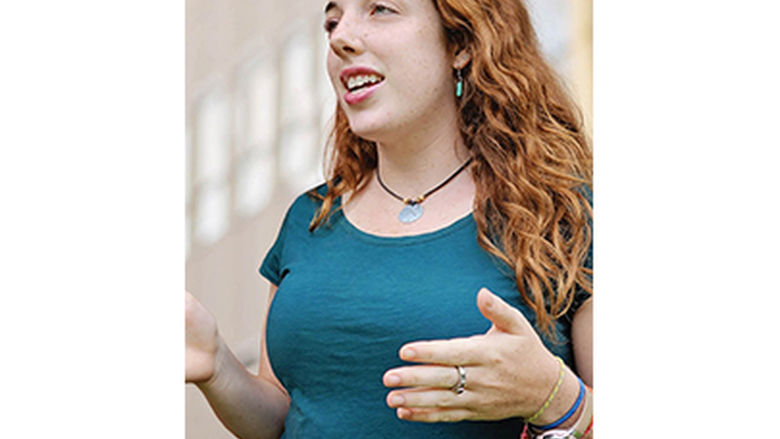
READING, Pa. — What does the study of honey bees have to do with pollen variations and seasonal allergies? Science major Cassandra Darnell hopes to find out, through an ongoing independent study she is conducting on the honey bees that she brought to Penn State Berks.
In the spring of 2016, Darnell set up four bee boxes at the Berks campus. She brought two of her bee boxes with established colonies, each approximately 50,000 strong, and two additional colonies, that she purchased for the project, with 10,000-member packages.
Over the spring and summer months, Darnell visited the campus regularly and collected pollen from the bees. Then she examined the pollen with the help of Greglynn Gibbs, research support technician in chemistry at Penn State Berks. Gibbs has been assisting Darnell with identification of the various types of pollen, using a Leica DM750 microscope with an ICC50 HD camera to capture images.
“In the spring, I collected a lot of different types of tree pollen from the bees and then there was a limited amount during the summer dearth," said Darnell. The summer dearth refers to the period when nectar is scarce due to limited flowering seasons, drought, and other conditions.
"By mid-September, the pollen comes out again with the blooming of asters and golden rod, and I’m finding the allergenic pollens in the bees," she adds. "This supports the idea that using native bee pollen could possibly help people with allergies."
“It’s very interesting to analyze which flowers the honey bees are collecting pollen from, and the types of pollen itself, and see how that changes from season to season,” adds Gibbs, who is also working to identify pollen from solar-powered pollen collectors on campus for another project. “It’s fascinating to see what the bees are collecting vs. what we’ve collected through the air. The bees are focused on specific flowers and they know exactly where to go.”
Harvesting pollen from honey bees can be a sticky situation
Honey bees travel from flower to flower, collecting nectar and pollen. They collect hundreds, sometimes millions, of pollen grains from a single flower, that adhere to the tiny hairs on the back of their hind legs. Meanwhile, they secrete a sticky substance from their stomach to help pack the pollen into granules. Carrying just two granules of pollen at a time, they travel back to the hive or bee box with their bounty and feed the pollen to their young.
To collect the bee pollen, beekeepers like Darnell attach a small screen in the doorway of a bee box. The screen allows the bees to enter and exit while harmlessly removing the pollen from their legs. Beekeepers are careful to collect only a small amount, so as not to deprive the bees of this food source.
Urban Bees vs. Rural Bees
The next step for Darnell is to save enough money to purchase four additional bee boxes, which she plans to install — with pollen collectors — on a farm on the opposite side of Berks County. She wants to compare the variation in types of pollen that she is collecting from the bees on campus with that from the bees she will place on the farm, hopefully in the spring of 2017.
“I would really like the pollen collection to run over the course of an entire year, and compare the pollen collection in an urban and rural setting,” said Darnell.
She explains that she wanted to study the bees on campus because Penn State Berks is located in a somewhat rural area with urban aspects, and currently there is a lot of interest in urban beekeeping.
Over the next year, Darnell will continue to collect data on pollen variation, honey production, and how well the bees survive in relation to similar apiaries in other areas.
“I won’t know how well the bees ‘over-winter’ until next March,” she said. Over-wintering refers to how well the bees survive the colder winter months.
Darnell works with Italian honey bees, Apis mellifera ligustica, which she explains are the “standard” honey bees. She likes to work with this subspecies because the bees are not as aggressive.
When asked how she got involved in beekeeping, Darnell said that her father actually asked her to do it with him. “My dad was listening to a radio program, and they had a home-and-garden show where they were interviewing a woman who kept beehives in the City of Reading in her backyard. My dad asked me if I wanted to try beekeeping with him, and I said 'sure.'”
“I hope that having the bees on campus might inspire Penn State Berks students to take up beekeeping or start a beekeeping club,” she said. “I would be happy to help anyone interested in getting started with this fascinating hobby.”
In addition to being a returning-adult student taking courses part-time at Penn State Berks, Darnell is a full-time mother to three children and a member of the Lehigh Valley Beekeepers Association, the Pennsylvania Beekeepers Association and the Eastern Apicultural Society.


